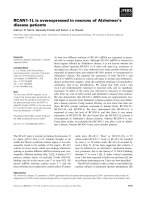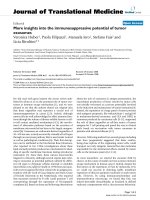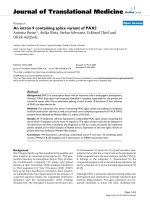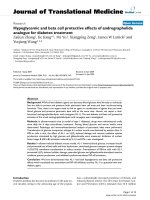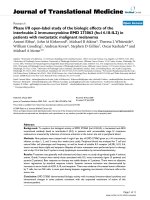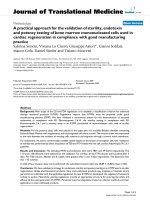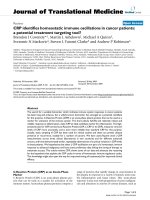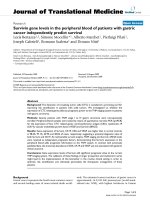báo cáo hóa học: " CRP gene variation affects early development of Alzheimer’s disease-related plaques" pdf
Bạn đang xem bản rút gọn của tài liệu. Xem và tải ngay bản đầy đủ của tài liệu tại đây (729.14 KB, 9 trang )
RESEARCH Open Access
CRP gene variation affects early development of
Alzheimer’s disease-related plaques
Eloise Helena Kok
1*
, Mervi Alanne-Kinnunen
2
, Karita Isotalo
1
, Teemu Luoto
3
, Satu Haikonen
1
, Sirkka Goebeler
4
,
Markus Perola
5
, Mikko A Hurme
1
, Hannu Haapasalo
1
and Pekka J Karhunen
1
Abstract
Introduction: We used the Tampere Autopsy Study (TASTY) series (n = 603, age 0-97 yrs), representing an
unselected population outside institutions, to investigate the pathogenic involvement of inflammation in
Alzheimer’s disease-related lesions.
Methods: We studied senile plaque (SP), neurofibrillary ta ngles (NFT) and SP phenotype associations with 6
reported haplotype tagging single nucleotide polymorphisms (SNPs) in the CRP gene. CRP and Ab
immunohistochemistry was assessed using brain tissue microarrays.
Results: In multivariate analyses (age- and APOE-adjusted), non-neuritic SP were associated with the high-CRP TA-
genotype (3.0% prevalence) of rs3091244 and CA-genotype (10.8%) of rs3093075 compared to common genotypes.
Conversely, the low-CRP C allele (39.3%) of rs2794521 reduced the risk of harbouring early non-ne uritic SP,
compared to the TT genotype. CRP haplotype TAGCC (high) associated with non-neuritic SP, whereas haplotype
CCGCC offered protection. TT genotypes (high) of rs3091244 and rs1130864 were associated with CRP staining.
There were no associations between SNPs or haplotypes and NFT. CRP staining of the hippocampal CA1/2 region
correlated with Ab staining.
Conclusions: CRP gene variation affects early SP development in prodromal Alzheimer’s disease, independent of
APOE genotype.
Background
TheonlymethodfordefinitivediagnosisofAlzheimer’s
disease (AD) to date is postmortem examination of the
brain. Current understanding indicates that the neuro-
pathological hallmarks, senile plaques (SP) and neurofibril-
lary tangles (NFT) develop within the brain, interrupting
neuronal signalling and causing the irreversible symptoms
of memory impairment and gradual cognitive decline
[1,2]. Efforts to prevent or slow the disease are ham pered
by a lack of understanding as to how these neuropatholo-
gical hallmarks develop and actually cause the disease - if
they do.
There are two forms of AD - familial and sporadic -
of which the sporad ic is much more common, compris-
ing 96% of all cases. Familial AD (FAD) is mostly caused
by mutations in 3 particular genes (amyloid precursor
protein, presenilin 1 and presenilin 2) [3], which are
directly related to the formation of SP. This has lead
researchers to believe that SP are the main culpri t in all
forms of AD. Many studies have revealed environmental
and genetic factors that affect the risk of sporadic AD,
such as exercise, education level and the ε 4alleleof
APOE [4].
At present, the apolipoprotein E (APOE) ε4 allele is the
only commonly accepted gene known to confer increased
risk for sporadic AD, whilst the rare ε2 allele is believed to
convey protection. Various studies have f ound ORs of
between 2 and 8, as well as lowering the age of onset, with
ε4 allele dosage [5,6]. Recently, genome wide association
studies [7-9] have revealed some lower imp act genes that
may increase AD risk, possibly accounting for a part of the
remaining unexplained ~50% of genetic risk effects. Many
other genes have also been suggested to increase the risk
of AD, but the evidenc e has been conf licting, with APOE
being the only consistent association.
* Correspondence:
1
School of Medicine, University of Tampere and Centre for Laboratory
Medicine, Tampere University Hospital, Tampere Finland
Full list of author information is available at the end of the article
Kok et al. Journal of Neuroinflammation 2011, 8:96
/>JOURNAL OF
NEUROINFLAMMATION
© 2011 Kok et al; licensee BioMed Central Ltd. This is an Open Access article distributed under the terms of the Creative Commons
Attribution License ( which permits unrestricted use, distribution, and reproduction in
any medium, provided the original work is properly cited.
The possible connection between AD and inflammation
was ignited by a study [10] showing a reduced incidence
of AD in a cohort of rheumatoid arthritic patients taking
non-steroidal anti-inflammatory drugs (NSAIDs), however
other studies have disputed this connection [11]. New
research [12-14] supports this, as many inflammatory mar-
kers have been found localised with the neuropathological
characteristics of AD; these include neuroinflammatory
cells, astrocytes, and microglia. Recent genome wide asso-
ciation studies have also shed light on this, with inflamma-
tory genes being put in the spotlight [9]. It has also been
suggested that chronic inflammation in the brain from
various bacterial/viral diseases could contribute to the dis-
ease [15,16]. Interactions between inflammatory gene
polymorphisms and invading pathogens have also been
proposed to participate in disease manifestation [17]. The
question remains, however, whether the inflammatory
processes ar e a cause or consequence of the disease, as a
majority of previous studies have been conducted in
advanced stage AD cases.
C-reactive protein (CRP) is an acute phase inflamma-
tory marker found in plasma, primarily produced by the
liver to combat pathogens thro ugh activation of immune
responses [18]. Additionally, CRP activates the cleanup of
cellular debris through its ac tion as a pattern recognition
receptor involving calcium-dependent ligand binding
[19]. Its role in AD has already been suggested by work
by Yasojima et al., which showed that CRP production is
upregulated in affected areas of AD brains [20].
Some single nucleoti de polymor phisms (S NPs) of the
CRP gene have been shown to associate with higher CRP
levels. One of the most influential of these polymorphisms,
identified in a genome-wide association study, was
rs3091244 (T and A alleles), as well as others; rs1130864
(T allele), rs1205 (G allele) and rs3093075 (C allele)
[21-23]. The SNP rs2794521 (T allele) has been reported
to increase transcription of the CRP allele [24,25]. Haplo-
types associated with 2-3-fold increases in CRP levels cor-
relate with poorer survival in general of elderly subjects
[22]. Lower CRP levels have been associated with the C
allele of SNP rs1800947 [21,26,24,27] and common haplo-
types of the gene are also associated with serum CRP con-
centration [24].
We have shown previously that accumulation of AD
neuropath ological lesions is unexpectedly common, with
31.1% of individuals living outside institutions having SP
and 42.1% having NFT [28]. This accumulation starts
already around 30 years of age, especially among the
carriers of the APOE ε4 allele, reaching an occurrence
of almost 100% in the oldest. Other studies have also
shown associations with the APOE ε4 all ele and both SP
and NFT [29,30].
We hypothesised that individuals with CRP genotypes
associated with higher CRP production would be more
likely to show development of SP already in the prodro-
mal phase before the development of clinical AD. At the
least, these phenomena might participate in the early
stages in the development of the lesions. We explored
potential associations between the CRP gene and the
brain changes commonly linked to AD in a large
autopsy cohort representing a population living outside
institutions, of which the majority were non-AD patients
who died mainly out-of-hospital. As far as we are aware,
this is the first study that has looked at the asso ciation
between AD pathology and CRP, both at a genetic and
cellular level.
Methods
Cohort
The Tampere Autopsy Study (TASTY) cohort comprises
603 men and women aged 0 - 97 years who were
subjected to medico-legal autopsy and generally died
out-of-hospital in Finland during the years 2002-2004,
representing around 4% of deaths in the Tampere region.
None died of AD causes, although 6 (< 1%) were clini-
cally diagnosed with A D durin g life, 22 (3.7%) were
demented and 10 (1.7%) had memory problems.
Recorded causes of death are given in table 1; more
detailed causes of death are not available. Further data on
illnesses and/or medication use during life are not acces-
sible to the researchers. Autopsies were performed by the
department of Forensic Medicine at the University of
Tampere and data pertaining to the cases were obtained
from doctors and family members where possible. The
study was approved by the Board of Medicolegal Affairs
of Finland.
Senile plaques and neurofibrillary tangles
SP and NFT assessments were made as previously
described [28]. A large number (70%) of cases had ‘no SP’
and using this skewed data as a continuous variable
would make analyses invalid; therefore we categorised
the SP into the following categorisations: ≥1SP(yes/no),
and S P typing (no SP, non-neuritic SP (diffuse/primitive),
neuritic SP (classic/burnt out)). Analyses also investigated
SP density in a semi-quantitative manner, dividing
SP counts into ‘ no SP’ , ‘ sparse SP’ , ‘moderate SP’ and
‘frequent SP’, comprising a scoring system based on the
CERAD protocol (but without age adjustment). We cate-
gorised NFT as: ≥1 NFT (yes/no). NFT and SP were
defined by a neuropathologist assessing grid regio ns of
complete brain samples on Bielschowsky-stained slides of
frontal cortex (SP) and hippocampus (NFT) in each case.
In our cohort, females were older on average by 10 years,
causing the category of gender to represent age, however
analyses showed similar results when split by gender.
Therefore gender was excluded as a covariate in our
analyses.
Kok et al. Journal of Neuroinflammation 2011, 8:96
/>Page 2 of 9
Tissue microarrays
Tissue microarrays (TMAs) were also constructed (as
described in [28]), to allow easier and simultaneous analy-
sis of multiple cases, and held approximately 10-14 cases
per block. TMAs were utilised for immunohistochemistry
for CRP and Ab staining. Brain regions that were incorpo-
rated into the TMAs were the hippocampal regions CA1,
CA2, CA3, and CA4; cerebellum, neocortex (frontal lobe),
gyrus cinguli and cerebrum (white matter). Technical diffi-
culties and sample damage precluded inclusion of all
TASTY cases, but 92.5% were incorporated.
Genotyping
CRP genotyping was performed at Biomedicum, Hel-
sinki (MA) on the Sequenom MassArray system with
the homogeneous Mass Extension (hME) reaction
(Sequenom, San Diego, USA) for 6 reported haplotype
tagging single nucleotide polymorphisms (SNPs), includ-
ing rs2794521 (T > C), rs3091244 (C > T > A),
rs1800947 (G > C), rs1130864 (C > T), rs1205 (C > T)
and rs3093075 (C > A). Haplotyping was calculated with
5 SNPs (SNP order: rs2794521, rs3091244, rs1800947,
rs1130864 and rs1205; rs3093075 was excluded as it
produced too many low prevalence haplotypes) using
the PHASE program [31,32] (version 2.1.1) and indi-
cated five haplotypes with prevalence above 5%.
Immunohistochemistry
Fluorescent immunohistochemical (F-IHC) staining was
performed on the TASTY-TMAs in the hippocampal
CA1/2 area and utilised DAPI (Sigma-Aldrich, Germany),
rabbit anti-CRP (BioLegend, USA), mouse anti-Ab (Acris
Antibodies, Germany), anti-mouse IgG FITC conjugated
(Novus Biologicals, USA), anti-rabbit IgG rhodamine
conjugated (Antibodies-online, Germany), all according
to manufacturer’s instructions. For analyses, cases were
assessed as positive or negative for staining.
Statistics
Statistical analyses were performed with an SPSS pro-
gram (version 14.0). Analyses for CRP SNPs and haplo-
types used the most common genotype or previously
reported ‘risk’ allele as the reference group and included
APOE4 carriership and age as covariates where possible.
Their associations were analysed using logistic regression.
Chi square analysis was used to determine association
with IHC staining. False discovery rate (FDR) multiple
correction calculations were performed assuming there
were 11 independent tests (6 SNPs and 5 haplotypes),
using the calculation below and a ssuming an FDR value
of < 0.05 was acceptable.
FDR = p − value x number of tests / p − value rank
Results
Cohort
The Tampere Autopsy Study (TASTY) (Table 1) con-
sisted of 603 autopsy cases (35.7% females) of subjects
who died mainly out-of-hospital over a three year per-
iod. Data on memory problems or possible dementia
were collected from hospital records and/or next of kin.
Of the series 558 cases (92.5%) were included in the
brain tissue microarray (TMA) construction. Not all
samples were included due to data discrepancies, techni-
cal issues and sample decay/damage.
Senile plaques and neurofibrillary tangles
Senile plaque (SP) frequency was available for 553
(90.9%), and neurofibrillary tangle (NFT) counts for
Table 1 The Tampere Autopsy Study (TASTY)
characteristics
Number of cases 603
Gender
Males 388 (64.3%)
Females 215 (35.7%)
Age (years)
1
62.7 (range 0 - 96.7)
Cause of Death
Disease 340 (56.5%)
Accident 177 (29.5%)
Suicide 72 (12.0%)
Homicide 3 (0.5%)
Unknown 9 (1.5%)
Brain Mass (g)
1
1408.1 (range 427 - 1910)
Dementia Status
Normal 570 (94.5%)
AD 6 (0.9%)
Dementia 16 (2.7%)
Memory Problems 10 (1.7%)
Parkinson’s Dis 1 (0.2%)
APOE Genotype
APOEε3ε3 356 (59.2%)
APOEε2ε3, ε2ε2 58 (9.7%)
APOEε4+ 187 (31.1%)
SP Presence
No 381 (68.9%)
Yes 172 (31.1%)
CERAD score
<0% 379
0 - 1.053% 85
1.053% + 85
NFT Presence
No 280 (57.9%)
Yes 204 (42.1%)
1
- statistical mean.
Kok et al. Journal of Neuroinflammation 2011, 8:96
/>Page 3 of 9
484 (80.3%). Both lesions were positively associated with
age [28].
Genotyping
APOE genotyping was performed on 601 cases and CRP
genotypes were acquired for 537 cases (89%). APOE and
CRP genotyping indicated that there were no significant
differences in the distribution of allele frequencies in
each age group, and that they followed Hardy-Weinberg
proportions.
Associations between genotypes and neuropathological
lesions
Univariate logistic regression analysis showed that the
SNP rs2794521 (p = 0.067) was associated with SP preva-
lence (yes/no SP presence). However, including age and
APOE4 carriership as covariates weakened the associa-
tion (p = 0.096).
When we took into account the phenotype of SP (Table
2), two high -CRP level-linked SNPs - rs3091244 (TA car-
riers; OR 6.7, p = 0.007) and rs3093075 (CA carri ers; OR
3.5, p = 0.003) - appeared to convey increased risk for
early non-neuritic SP compared to no SP. There was also
a tendency towards increased risk for late neuritic SP
(OR 4.5, p = 0.072; OR 2.1, p = 0.080, respectively).
On the contrary, carriers of the low -CRP level-linked
C allele of SNP rs2794521 (OR 0.46, CI 0.22 - 0.96, p =
0.039) were less likely to h ave non-neuritic SP, derived
from an association with the common CT genotype (OR
0.43, p = 0.037). A trend towards the same associations
was seen with neuritic SP. Conversely, the high-CRP
level SNPs rs1130864 (TT carriers; OR 0.26, p = 0.076)
andrs1205(CCcarriers;OR0.39,p=0.056)showeda
non-significant trend towards protection for non-neuri-
tic compared to no SP.
In multivariate logistic regression, CRP haplotypes
composed of alleles related to high-CRP levels, such as
TAGCC, w ere associated with presence of non-neuritic
SP (OR 2.99, p = 0.007), significantly increasing the risk
of occurrence (Table 3). On the contrary, haplotype car-
riership of alleles linked with lower CRP levels, such as
CCGCC, reduced (OR 0.45, p = 0.034) the likelihood of
possessing non-neuritic SP. Similar, but-non significant
tendencies towards these associations were also seen for
both haplotypes and neuritic SP.
Haplotype pair analyses c ompared all haplotype pai rs
with prevalence above 6% against the most common pair
(TTGTC/TCGCT). None of the haplotype pairs were
associated with SP prevalence. Analyses with SP pheno-
type suggested a trend towards protection for the haplo-
type pair T TGTC/TTGTC (p = 0.065) and TCGCT/
CCGCC (p = 0.070) with non-neuritic SP, although the
association weakened with the inclusion of age and
APOE4 carriership as covariates (data not shown).
NFT prevalence (yes /no presen ce) showed an associa-
tion only with SNP rs2794521, using univariate logistic
regression (p = 0.059). Inclusion of APOE genotype and
age as covariates weakened the association (p = 0.107).
Semi-quantitative analyses of SP density did not reveal
any significant associations with any of the CRP geno-
types, and splitting the databygenderdidnotprovide
any additional results (data not shown).
Immunohistochemistry
CRP IHC staining (positive/negative) was found to be sig-
nificantly correlated with Ab (amyloid-b) s tainin g (posi-
tive/negative) in all studied brain regions in the cohort,
(Chi square p < 0.0001, Figur e 1). Ab IHC staining, how-
ever, was not found to be associated with any of the CRP
SNPs or haplotypes. In univariate analyses, CRP IHC
staining was significantly associated with high-CRP level
TT genotypes of SNPs rs3091244 (OR 5.9, CI 1.20 -
28.87, p = 0.029) and rs1130864 (OR 5.9, CI 1.21 - 28.95,
p = 0. 028) (Figure 2 ). Individual haplotyp e (yes/no car-
riership) were not, but the haplotype pair TTGTC/
TTGTC was significan tly associated (OR = 5.5, CI = 1.03
- 29.48, p = 0.047) with CRP IHC staining. This relation-
ship strengthened on inclusion of APOE4 carriership and
age as c ovariates (OR = 14.9, CI = 1.14 - 196.37, p =
0.040), however the CI were extremely large.
Multiple testing correction
We performed FDR calculations on our results, assuming
that 11 independent tests were performed (6 SNPs and 5
haplotypes). These showed that with an FDR < 0.05, or
5% false positives, most of our results were still applicable
(see Table 4). The SNPs and haplotypes of the CRP gene
which were seen most often in analyses were rs2794521
(genotype CT), rs3091244 (genotypes TA and TT),
rs3093075 (genotype CA) and haplotype TAGCC.
Discussion
The mechanisms underlying AD have been sought for
more than 100 years, with not more than a few risk factors
being identified, and the development of therapeutics has
been based on treating symptoms, rather than reversing or
curing the disease. Increasing population and average life-
span will see the number of AD sufferers escalate, accord-
ing to current estimates, which will stress healthcare and
treatment services.
Common understanding relates SP (aggregations of
amyloid-b (Ab) protein) and NFT (accumulations of
hyperphosphorylated tau protein) in the brains of AD
subjects as causes of the disease, with both triggering
inflammation and disrupting neuronal signalling, and SP
also implicated in genetic mutations of familial AD [3].
Our recently published study [28] on the prevalence of
these brain lesions suggests that they are much more
Kok et al. Journal of Neuroinflammation 2011, 8:96
/>Page 4 of 9
frequent, and occur i n younger individuals, than pre-
viously thought, although whether the disease process
also begins earlier is yet to be ascertained.
The inflammation theory was developed after epide-
miological studies revealed a 6-times smaller incidence
of AD in a cohort of patients receiving NSAIDs for
rheumatoid arthritis, compared to a control group
[10,33]. Whilst the effectiveness of NSAIDs is controver-
sial in the treatment of AD [33], there is still a common
consensus that inflammation is an important part of the
AD process.
CRP is an acute phase inflammatory marker found in
plasma. CRP level s have be en shown to be upregulated
in affected areas of AD brains [20]. Polymorphisms in
the CRP gene associated with elevated CRP levels have
been shown to increase mortality [22]. Research has
implicated genetic facto rs as determining 27-40% of var-
iance in plasma CRP levels [24,25].
A relationship between CRP genotype and NFT was not
seen in our cohort, as was also the case in our earlier
study of APOE genotype [28]. NFT formation is presumed
to be secondary to SP production [34]; thus the lack of an
Table 2 Multivariate logistic regression for SP type (no SP - reference group, non-neuritic SP and neuritic SP) and
association with CRP SNPs (APOE4 carriership and age were included as covariates)
Non-Neuritic SP Neuritic SP
Assoc. Total Prev % Affected (%) OR CI p Affected (%) OR CI p
rs2794521 TT* T allele
- high
321 60.8 36 11.2 1 Ref - 68 21.2 1 Ref -
CC 25 4.7 2 8.0 0.673 0.142 - 3.200 0.619 8 32.0 1.265 0.410 - 2.272 0.683
CT 182 34.5 13 7.1 0.433 0.197 - 0.952 0.037
a
26 14.3 0.600 0.317 - 1.138 0.118
rs3091244 CC* T & A
alleles
- high
179 33.7 18 10.1 1 Ref - 32 17.9 1 Ref -
TT 73 13.7 2 2.7 0.290 0.063 - 1.334 0.112 19 26.0 1.829 0.786 - 4.254 0.161
TA 16 3.0 5 31.3 6.717 1.673 - 26.978 0.007
a
3 18.8 4.535 0.873 - 23.555 0.072
CA 41 7.7 7 17.1 1.771 0.606 - 5.172 0.296 9 22.0 2.117 0.730 - 6.139 0.167
AA 3 0.6 0 0 . . . 0 0 . . 0.998
TC 219 41.2 20 9.1 0.819 0.384 - 1.744 0.604 40 18.3 1.179 0.589 - 2.361 0.642
rs1800947 GG* C allele
- low
457 86.4 43 9.4 1 Ref - 89 19.5 1 Ref -
CC 5 0.9 1 20.0 7.107 0.419 - 120.535 0.175 2 40.0 3.814 0.160 - 90.798 0.408
GC 67 12.7 7 10.4 1.428 0.579 - 3.526 0.439 12 17.9 0.700 0.270 - 1.813 0.463
rs1130864 CC* T allele
- high
220 42.2 25 11.4 1 Ref - 40 18.2 1 Ref -
TT 72 13.8 2 2.8 0.258 0.058 - 1.154 0.076 19 26.4 1.645 0.738 - 3.666 0.224
TC 229 44.0 24 10.5 0.898 0.461 - 1.748 0.751 43 18.8 1.185 0.630 - 2.229 0.599
rs1205 TT* C allele
- high
65 12.3 9 13.8 1 Ref - 12 18.5 1 Ref -
CC 224 42.5 15 6.7 0.397 0.154 - 1.025 0.056 51 22.8 1.492 0.584 - 3.814 0.403
CT 238 45.2 28 11.8 0.675 0.281 - 1.623 0.380 40 16.8 0.949 0.363 - 2.478 0.914
rs3093075 CC* C allele
- high
469 88.7 39 8.3 1 Ref - 91 19.4 1 Ref -
AA 3 0.6 0 0 . . . 0 0 . . .
CA 57 10.8 12 21.1 3.492 1.545 - 7.894 0.003
a
12 21.1 2.143 0.914 - 5.022 0.080
* denotes the most common homozygous genotype acting as the reference group in analyses.
. denotes the values were unable to be computed.
a
denotes statistically significant values.
Non-neuritic SP are diffuse and primitive SP grouped together, neuritic SP are classic an d burnt out SP grouped together; as measured by a neuropathologist.
Prev % refers to prevalence of alleles.
Assoc. refers to associations with CRP levels.
CRP = c-reactive protein gene, SNPs = single nucleotide polymorphisms, SP = senile plaques, OR = odds ratio, CI = confidence interval, p = p value.
Kok et al. Journal of Neuroinflammation 2011, 8:96
/>Page 5 of 9
association with CRP genotypes and NFT and the idea that
CRP polymorphisms would be related only to SP is
consistent.
The findings of our current work that some hig h-CRP
level polymorphisms correlate with early non-neuritic
SP allows us to hypothesise that increased inflammatory
levels may initiate or participate in the primary devel op-
ment of lesions, which then leads to other processes and
damage to neurons, thus setting off a chain of events
leading to AD. The absence of statistically significant
associations between CRP genotypes and late-stage
neuritic SP could be due to other factors acting upon
SP development, such as effects of immune cells, includ-
ing microglia [35,36].
SNP rs2794521 has been previously reported to affect
expression levels of CRP, with the T allele increasing
transcription levels of the protein [24,25] compared to
the C allele. In our cohort, this was the only SNP that
associated with the occurrence of SP, with the most com-
mon CT geno type showing borderline significance for an
association with reduced risk of having at least one SP
(p = 0.067). When we further analysed the associations,
taking into account early or late SP phenotype, we found
that CRP SNP rs2794521 (C carriers) was significantly
associated with reduced risk of harbouring non-neuritic
SP. It may be possible that the CT genotype associates
with lower levels of CRP, thus interfering with formation
of SP. In contrast, high-CRP level SNPs (rs3091244, TA
Table 3 Multivariate logistic regression results for SP type (no SP - reference group, non-neuritic SP and neuritic SP)
and association with CRP haplotypes (APOE4 carriership and age were included as covariates)
Non-Neuritic SP Neuritic SP
Assoc. Total Prev % Affected (%) OR CI p Affected (%) OR CI p
TTGTC Yes* High-CRP 306 37.0 26 8.5 1 Ref - 62 20.3 1 Ref -
(1) No 225 26 11.6 1.402 0.740 - 2.656 0.300 41 18.2 0.776 0.435 - 1.383 0.390
TCGCC No* No assoc. 516 52 10.1 1 Ref - 96 18.6 1 Ref -
(3) Yes 15 1.2 0 0.0 . . . 7 46.7 4.124 0.700 - 24.278 0.117
TCGCT No* No assoc. 282 22 7.8 1 Ref - 61 21.6 1 Ref -
(4) Yes 249 30.0 30 12.0 1.397 0.736 - 2.651 0.307 42 16.9 0.686 0.386 - 1.217 0.197
TCCCT No* Low-CRP
in females
459 44 9.6 1 Ref - 89 19.4 1 Ref -
(5) Yes 72 6.6 8 11.1 1.545 0.655 - 3.644 0.321 14 19.4 0.775 0.312 - 1.923 0.582
TAGCC No* High-CRP 471 40 8.5 1 Ref - 91 19.3 1 Ref -
(6) Yes 60 5.2 12 20.0 2.985 1.342 - 6.638 0.007
a
12 20.0 1.809 0.785 - 4.167 0.164
CCGCC No* Low-CRP
in males
324 37 11.4 1 Ref - 69 21.3 1 Ref -
(7) Yes 207 19.5 15 7.2 0.453 0.218 - 0.941 0.034
a
34 16.4 0.680 0.376 - 1.228 0.201
* denotes the most common haplotype acting as the reference group in analyses.
. denotes the values were unable to be computed.
a
denotes statistically significant values.
Numbers in brackets referring to our own number allocation system for haplotypes.
Haplotypes consist of SNPs rs2794521 (T > C), rs3091244 (C > T > A), rs1800947 (G > C), rs1130864 (C > T) and rs1205 (C > T).
Non-neuritic SP are diffuse and primitive SP grouped together, neuritic SP are classic an d burnt out SP grouped together; as measured by a neuropathologist.
Prev % refers to prevalence of alleles.
Assoc. refers to associations with CRP levels.
CRP = c-reactive protein gene, SP = senile plaques, N = Number of cases, OR = odds ratio, CI = confidence interval, p = p value.
Figure 1 Co-localisation of CRP and Ab immunohistochemical staining (a) Ab staining (b) CRP staining (c) merge, 100 × magnification.
Kok et al. Journal of Neuroinflammation 2011, 8:96
/>Page 6 of 9
carriers and rs3093075 CA carriers) were strongly asso-
ciated with increased risk of non-neuritic SP. However as
a sign of the complex relationship between SNPs and
CRP levels, we found that other high-CRP level SNPs,
rs1130864 (TT carriers) and rs1205 (CC carriers), also
showed trends toward protection against non-neuritic SP
compared to no SP. These results nonetheless suggest a
role for the CRP gene, independent of APOE genot ype,
which was used as a covariate in these analyses.
The CCGCC haplotype contains the protective, low-
CRP protein-linked C allele for both rs2794521 and
rs3091244, whilst TAGCC has the high-CRP level T and
A alleles for the same SNPs. The effects of these SNPs
were corroborated in haplotype analyses showing that
CCGCC carriership reduces risk and TAGCC carrier-
ship increases risk for non-neuritic S P, with tendencies
in the same directions for neurit ic SP compared to no
SP. Our results, showing a correlation between CRP and
Ab IHC staining, support the involvement of inflamma-
tion in AD and correspond with other studies [20].
In line with previous reports and with our results
above, the high-CRP SNP rs3091244 (TT ge notype) was
significantly associated with CRP IHC staining in the
CA1/2 region. In contrast, the previously reported high-
CRP level TT genotype of rs1130864 was significantly
associated with positive staining, although our SP results
would suggest it has some protective effect in non-
neuritic SP formation. This could suggest that this SNP
mayconfermoreeffectiveclean-upabilities,andthat
higher levels, in this case, are not detrimental.
The absence of an association between Ab staining and
CRP genotype could be explained if CRP affects only SP
formation and not the pre sence of the Ab peptide itself,
which is the product of normal amyloid precursor protein
processing [37]. This makes sense, given the revealed asso-
ciations between CRP genotypes and SP types in our study.
AsthemajorityoftheTASTYseriesarenon-AD
cases, correlative f indings between CRP genotypes and
SP prevalence reveal an interesting insight into the early
development of AD neuropathology. It is possible that
these SP-positive cases could be in a prodromal phase
of the disease and may later have developed AD, had
they lived. We recently showed, however, that 31% of
Figure 2 CRP SNPs and prevalence of CRP
immunohistochemical staining (positive/negative) with SNPs
rs3091244 and rs1130864. Genotypes in order of population
frequency, with * referring to ‘no CRP staining’ versus ‘positive
staining’ with most common genotype as reference group.
Table 4 Results validated by FDR < 0.05 cutoff limit
p-value SNP (and genotype) or Haplotype Association
p< 0.0001 n/a Ab IHC and CRP IHC stainings (Chi square)
p = 0.003 rs3093075 (genotype CA) Increased risk of non-neuritic SP
p = 0.007 rs3091244 (TA) Increased risk of non-neuritic SP
p = 0.007 Haplotype (6) TAGCC Increased risk of non-neuritic SP
p = 0.037 rs2794521 (CT) Reduced risk of non-neuritic SP
p = 0.076 rs1130864 (TT) Reduced risk of non-neuritic SP
p = 0.076 Haplotype (4) TCGCT Reduced risk of having NFT
p = 0.080 rs3093075 (CA) Increased risk of neuritic SP
p = 0.083 rs2794521 (CT) More likely to have CRP IHC staining
p = 0.087 rs3093075 (CA) Less likely to have CRP IHC staining
p = 0.090 Haplotype (6) TAGCC Less likely to have CRP IHC staining
p = 0.112 rs3091244 (TT) Reduced risk of non-neuritic SP
p = 0.118 rs2794521 (CT) Reduced risk of neuritic SP
Kok et al. Journal of Neuroinflammation 2011, 8:96
/>Page 7 of 9
the subjects in this series harbour SP, and that this pre-
valence increased to almost 100% in the oldest old. This
questions the relevance of SP prevalence and the rela-
tionship between these brain lesions and AD itself.
Our data suggest that CRP genotype may modify initial
SP formation i n the brain. This is an interesting finding
that will need to be investigated further in cohorts com-
prising only of AD cases, and replicated in larger epide-
miological studies. It may be that CRP polymorphisms
associate with or participate in the slowing down or
enhancement of early stage SP but, after this, other factors
come into play to effect conversion to late-stage SP. As
end-stage SP are more likely to be associated with demen-
tia than other types [34], this could explain why NSAID
treatments in clinical AD patients have proven ineffective
at slowing or reversing the disease, as inflammation may
already have played its part. Based on our s tudies and
others’ results, the brains of most middle-aged to elderly
persons possess some degree of persistent inflammation as
well as SP and NFT. It could therefore be assumed that
other factors aside from CRP genotype participate in the
conversion of these ‘benign’ SP, to pathological SP types
related to AD.
Whilst it may be that the younger aged cases and con-
sequential low numbers of SP may reduce power, and
mayhavecausedsomeofourresultstorepresentfalse
positives, our cohort is a large autopsy series, showing
the prevalence of these brain lesions in a sample repre-
sentative of a general non-institutionalised population.
Conclusions
The common occurrence of these AD-related brain lesions
and the subclinical elevations in elderly patients of inflam-
matory markers [38], as well as our current results, suggest
that these are simply a consequence of brain aging without
any relationship to clinical AD. The co nversion of these
pathways into those causing AD, however, are yet to be
ascertained and remain controversial.
Abbreviations
AD: Alzheimer’s disease; APOE: apolipoprotein E; CRP: C-reactive protein;
FDR: false discovery rate; NFT: neurofibrillary tangles; NSAIDs: non-steroidal
anti-inflammatory drugs; SNPs: single nucleotide polymorphisms; SP: senile
plaques; TASTY: Tampere autopsy study; TMAs: tissue microarrays.
Acknowledgements
Many thanks to Heini Huhtala and Ilkka Seppälä (for assistance with
statistical analyses), Leena Viiri (for help with the PHASE program for
haplotyping), Markku Pelto-Huikko (for guidance during fluorescent
microscopy) and Ulla Jukarainen (for discussions and help regarding
fluorescent immunohistochemistry). This work was supported by funds from
the Medical Research Fund of Tampere University Hospital, the Pirkanmaa
Regional Fund of the Finnish Cultural Foundation, the Finnish Foundation
for Cardiovascular Research, and the Yrjö Jahnsson Foundation.
Author details
1
School of Medicine, University of Tampere and Centre for Laboratory
Medicine, Tampere University Hospital, Tampere Finland.
2
Wihuri Research
Institute, Helsinki, Finland.
3
Department of Neurosciences and Rehabilitation,
Tampere University Hospital, Tampere, Finland.
4
National Institute for Health
and Welfare, Tampere, Finland.
5
Department of Chronic Disease Prevention,
National Institute for Health and Welfare, Unit of Public Health Genomics,
Helsinki, Finland; Institute for Molecular Medicine Finland FIMM, University of
Helsinki, Helsinki, Finland; Department of Medical Genetics, University of
Helsinki, Helsinki, Finland.
Authors’ contributions
All authors contributed to this manuscript. EK performed experiments and
analyses and wrote the manuscript. MAK participated in writing the
manuscript and provided comments and discussions. KI performed
experiments. HH, TL and SH measured the neuropathological lesions. SG and
PJK collected the autopsy series. MP, MH, HH and PJK provided comments
and discussions on the progress of the manuscript. All authors have read
and approved the final version.
Competing interests
The authors declare that they have no competing interests.
Received: 23 March 2011 Accepted: 11 August 2011
Published: 11 August 2011
References
1. Pei J, Sjogren M, Winblad B: Neurofibrillary degeneration in Alzheimer’s
disease: from molecular mechanisms to identification of drug targets.
Curr Opin Psychiatry 2008, 21:555-561.
2. Kim Y, Lim S, Rhee S, Park K, Kim C, Choi B, et al: Resveratrol inhibits
inducible nitric oxide synthase and cyclooxygenase-2 expression in
beta-amyloid-treated C6 glioma cells. Int J Mol Med 2006, 17:1069-75.
3. Tanzi R, Kovacs D, Kim T, Moir K, Guenette S, Wasco W: The gene defects
responsible for familial Alzheimer’s disease. Neurobiol Dis 1996, 3:159-168.
4. Kidd PM: Alzheimer’s disease, mild cognitive impairment amnestic and
age-associated memory impairment: current understanding and
progress toward integrative prevention. Altern Med Rev 2008, 13:85-115.
5. Corder E, Saunders A, Strittmatter W, Schmechel D, Gaskell P, Small G, et al:
Gene dose of apolipoprotein E type 4 allele and the risk of Alzheimer’s
disease in late onset families. Science (Washington); 1993:261:828-9.
6. van Duijn C, Wehnert A, Van Broeckhoven C, Havekes LM, de Knijff P,
Cruts M, et al: Apolipoprotein E4 allele in a population-based study of
early-onset Alzheimer’s disease. Nat Genet 1994, 7:74-8.
7. Beecham GW, Martin ER, Li YJ, Slifer MA, Gilbert JR, Haines JL, et al:
Genome-wide Association Study Implicates a Chromosome 12 Risk
Locus for Late-Onset Alzheimer Disease. The American Journal of Human
Genetics 2009, 84:35-43.
8. Harold D, Abraham R, Hollingworth P, Sims R, Gerrish A, Hamshere ML,
et al: Genome-wide association study identifies variants at CLU and
PICALM associated with Alzheimer’s disease. Nat Genet 2009,
41:1088-U61.
9. Lambert JC, Heath S, Even G, Campion D, Sleegers K, Hiltunen M, et al:
Genome-wide association study identifies variants at CLU and CR1
associated with Alzheimer’s disease. Nat Genet 2009, 41:1094-U68.
10. McGeer PL, McGeer E, Rogers J, Sibley J: Anti-inflammatory drugs and
Alzheimer disease. Lancet 1990, 335:1037.
11. Breitner JCS, Haneuse SJPA, Walker R, Dublin S, Crane PK, Gray SL, et al: Risk
of dementia and AD with prior exposure to NSAIDs in an elderly
community-based cohort. Neurology 2009, 72:1899.
12.
Holmes C, Cunningham C, Zotova E, Woolford J, Dean C, Kerr S, et al:
Systemic inflammation and disease progression in Alzheimer disease.
Neurology 2009, 73:768-774.
13. Lee K, Chung J, Choi T, Suh S, Oh B, Hong C: Peripheral cytokines and
chemokines in Alzheimer’s disease. Dement Geriatr Cogn Disord 2009,
28:281-7.
14. Perry V, Nicoll J, Holmes C: Microglia in neurodegenerative disease. Nat
Rev Neurol 2010, 6:193-201.
15. Itzhaki RF, Wozniak MA: Herpes simplex virus type 1, apolipoprotein E,
and cholesterol: a dangerous liaison in Alzheimer’s disease and other
disorders. Prog Lipid Res 2006, 45:73-90.
16. Urosevic N, Martins R: Infection and Alzheimer’s disease: the APOE
epsilon4 connection and lipid metabolism. J Alzheimer’s Dis 2008,
13:421-35.
Kok et al. Journal of Neuroinflammation 2011, 8:96
/>Page 8 of 9
17. Kamer A, Craig R, Dasanayake A, Brys M, Glodzik-Sobanska L, de Leon M:
Inflammation and Alzheimer’s disease: Possible role of periodontal
diseases. Alzheimers Dement 2008, 4:242-250.
18. Pepys M, Hirschfield G: C-reactive protein: a critical update. J Clin Invest
2003, 111:1805-12.
19. Garlanda C, Bottazzi B, Bastone A, Mantovani A: Pentraxins at the
crossroads between innate immunity, inflammation, matrix deposition,
and female fertility. Annu Rev Immunol 2005, 23:337-366.
20. Yasojima K, Schwab C, McGeer E, McGeer P: Human neurons generate
C-reactive protein and amyloid P: upregulation in Alzheimer’s disease.
Brain Res 2000, 887:80.
21. Eklund C, Kivimaki M, Shaheenul Islam M, Juonala M, Kahonen M,
Marniemi J, et al: C-reactive protein genetics is associated with carotid
artery compliance in men in The Cardiovascular Risk in Young Finns
Study. Atherosclerosis 2008, 196:841-8.
22. Hurme M, Kivimaki M, Pertovaara M, Lehtimaki T, Karhunen PJ, Jylha M,
et al: CRP gene is involved in the regulation of human longevity: A
follow-up study in Finnish nonagenarians. Mech Ageing Dev 2007,
128:574-576.
23. Ridker PM: Loci related to metabolic-syndrome pathways including LEPR,
HNF1A, IL6R, and GCKR associate with plasma C-reactive protein: the
Women’s Genome Health Study. Am J Hum Genet 2008, 82:1185.
24. Teng M, Hsu L, Wu S, Change H, Choi H, Ko Y: Association between
C-reactive protein gene haplotypes and C-reactive protein levels in
Taiwanese: interaction with obesity. Atherosclerosis 2009, 204:e64-9.
25. Wang L, Lu X, Li Y, Li H, Chen S, Gu D: Functional analysis of the
C-reactive protein (CRP) gene -717A > G polymorphism associated with
coronary heart disease. BMC Med Genet 2009, 10:73.
26. Brull D, Serrano N, Zito F, Jones L, Montgomery H, Rumley A, et al: Human
CRP gene polymorphism influences CRP levels: implications for the
prediction and pathogenesis of coronary heart disease. Arterioscler
Thromb Vasc Biol 2003, 23:2063-9.
27. Lee C, You N, Song Y, Hsu Y, Manson J, Nathan L, et al: Relation of genetic
variation in the gene coding for C-reactive protein with its plasma
protein concentrations: findings from the Women’s Health Initiative
Observational Cohort. Clin Chem 2009, 55:351-60.
28. Kok E, Haikonen S, Luoto T, Huhtala H, Goebeler S, Haapasalo H, et al:
Apolipoprotein E-dependent accumulation of Alzheimer disease-related
lesions begins in middle age. Ann Neurol 2009, 65:650-7.
29. Ghebremedhin E, Schultz C, Braak E, Braak H: High Frequency of
Apolipoprotein E ε4 Allele in Young Individuals with Very Mild
Alzheimer’s Disease-Related Neurofibrillary Changes. Exp Neurol 1998,
153:152-155.
30. Braak H, Braak E: Frequency of Stages of Alzheimer-Related Lesions in
Different Age Categories. Neurobiol Aging 1997, 18:351-357.
31. Stephens M, Smith NJ, Donnelly P: A New Statistical Method for
Haplotype Reconstruction from Population Data. Am J Hum Genet 2001,
68:978-989.
32. Stephens M, Donnelly P: A comparison of bayesian methods for
haplotype reconstruction from population genotype data. Am J Hum
Genet 2003, 73:1162-9.
33. P Aisen s, A Fitzpatrick L, Ikram MA, A DeStefano L, Gudnason V, Boada M,
et al: The potential of anti-inflammatory drugs for the treatment of
Alzheimer’s disease. Lancet Neurol 2002, 1:279-84.
34. Duyckaerts C, Delatour B, Potier M: Classification and basic pathology of
Alzheimer disease. Acta Neuropathol 2009, 118:5-36.
35. Fukumoto H, Asami-Odaka A, Suzuki N, Iwatsubo T: Association of A beta
40-positive senile plaques with microglial cells in the brains of patients
with Alzheimer’s disease and in non-demented individuals.
Neurodegeneration, Neurodegen 1996, 5:13-7.
36. Ohgami T, Kitamoto T, Shin R, Kaneko Y, Ogomori K, Tateishi J: Increased
senile plaques without microglia in Alzheimer’s disease. Acta Neuropathol
1991, 81:242-247.
37. Haass C, Schlossmacher M, Hung A, Vigo-Pelfrey C, Mellon A, Ostaszewski B,
et al: Amyloid beta-peptide is produced by cultured cells during normal
metabolism. Nature 1992, 359:322-325.
38. Gallicchio L, Chang H, Christo D, Thuita L, Huang H, Strickland P, et al:
Single nucleotide polymorphisms in inflammation-related genes and
mortality in a community-based cohort in Washington County,
Maryland. Am J Epidemiol 2008, 167:807-813.
doi:10.1186/1742-2094-8-96
Cite this article as: Kok et al.: CRP gene variation affects early
development of Alzheimer’s disease-related plaques. Journal of
Neuroinflammation 2011 8:96.
Submit your next manuscript to BioMed Central
and take full advantage of:
• Convenient online submission
• Thorough peer review
• No space constraints or color figure charges
• Immediate publication on acceptance
• Inclusion in PubMed, CAS, Scopus and Google Scholar
• Research which is freely available for redistribution
Submit your manuscript at
www.biomedcentral.com/submit
Kok et al. Journal of Neuroinflammation 2011, 8:96
/>Page 9 of 9
